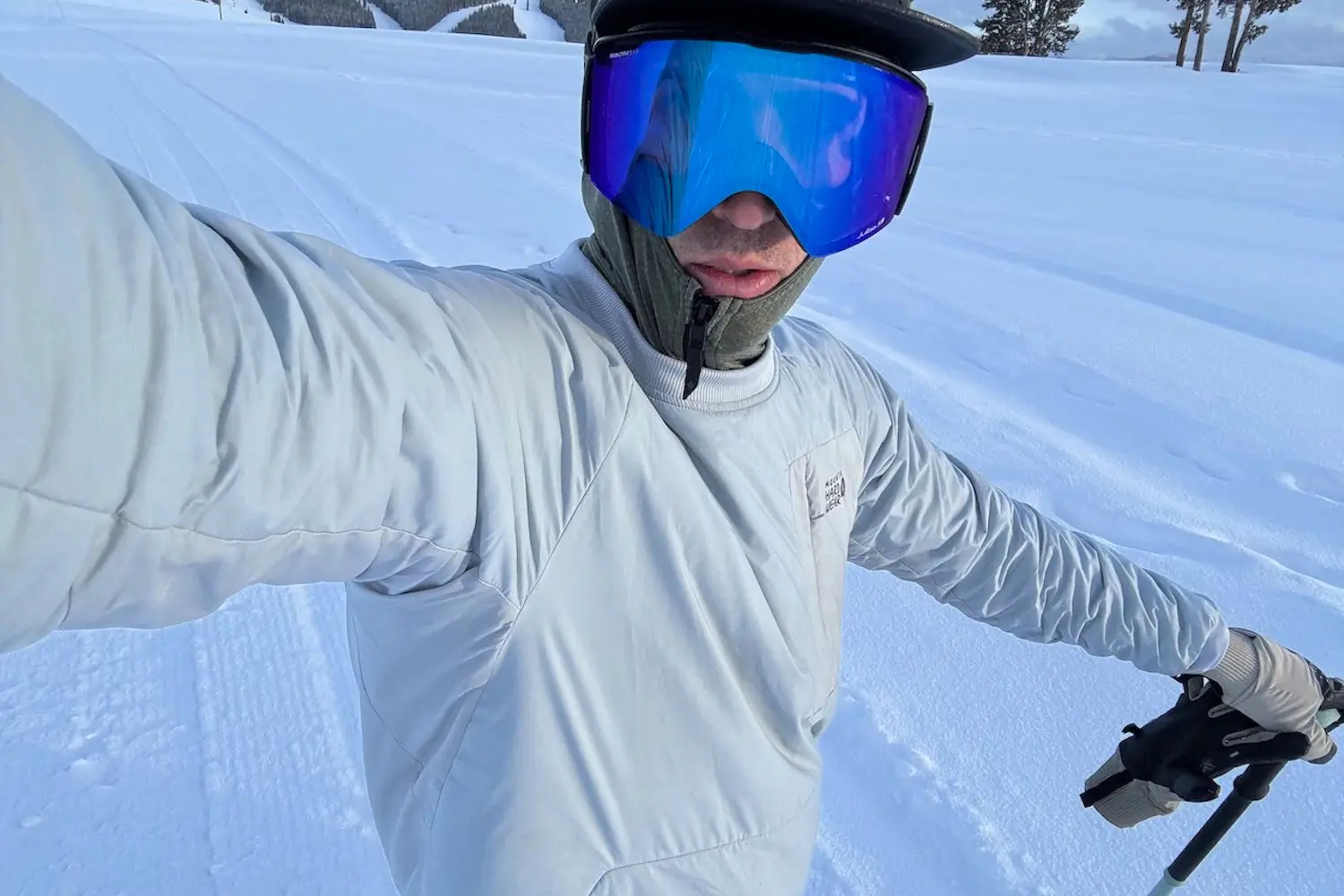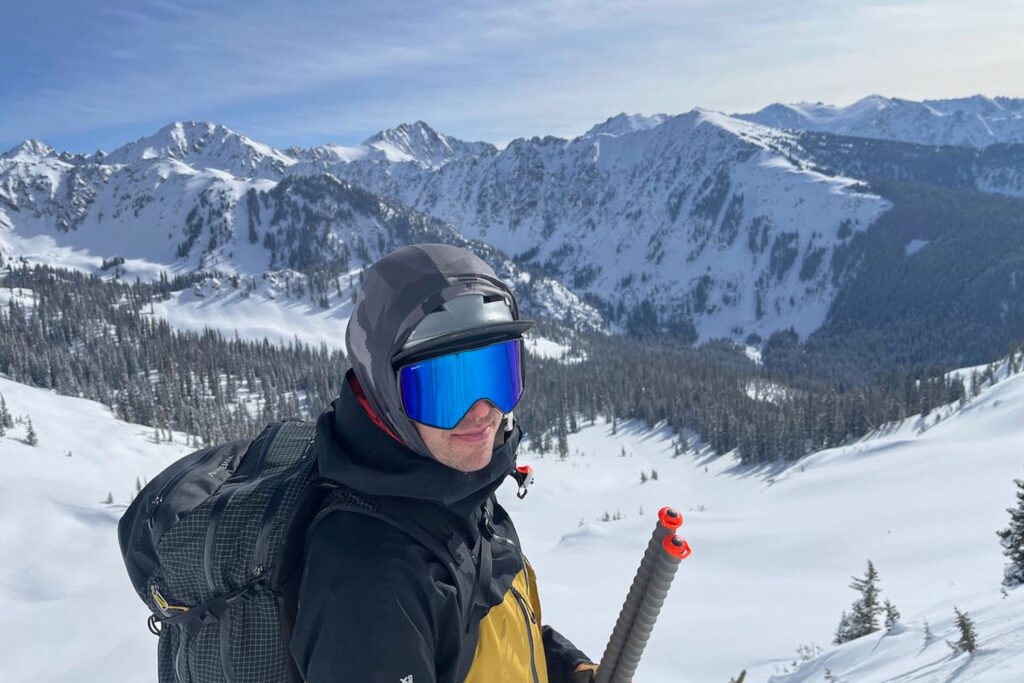I was cliffed out above 500 feet of exposure, while exploring a new descent that branched off a classic couloir I’d skied countless times. To make the situation worse, I was running late, and the afternoon sun was cooking the snow above me.
I hastily transitioned to ski crampons to bootpack up. Thankfully, my Julbo Launcher Reactiv ski goggles had a vent on the lens that I could open, rather than rummaging through my pack for sunglasses.
At first, I thought that Julbo’s venting feature might be a gimmick. “Simple is better” is also fundamental to my gear selection. But in situations like this one, where I’d rather skip a headwear transition, these goggles made sense.
After several weeks of testing in the backcountry and at the ski resort, I came to appreciate this ventilation system alongside other strengths of the Launcher Reactiv.
In short: French brand Julbo’s foray into the big goggles trend was worth the wait. The new Julbo Launcher Reactiv ski goggles ($290) offer a medium to large fit, a large field of vision, and premium features that make them distinct from other top-end offerings. The Launchers utilize Julbo’s proprietary cylindrical Reactiv 1-3 photochromic lens, which adjusts quickly and accurately to ambient lighting. Riders eager to earn their turns will be thrilled with the Launcher’s SuperFlow Pro venting feature that maximizes airflow and eliminates fogging. The catch? These highly featured goggles come with a premium tag that won’t make sense for every skier.
See how this design compares to a competitive lineup in the Ski Goggles buyer’s guide.
-
Superflow Pro Venting System eliminates fogging -
Top-end photochromic lens adapts quickly to changing light -
Edgeless frame and large lens offer big field of view
-
Expensive -
Testers felt some pressure on nose -
Optics not quite as precise as high-end competitors
Julbo Launcher Reactiv Ski Goggles Review
Subtleties differentiate most of the best snow goggles on the market. But there are outliers, like Julbo’s new Launcher Goggles, which have distinctive design elements and advanced versatility. I appreciated these goggles when the wind was hammering, the light was changing, and I hoofed it over rocky ridgelines.
Julbo’s SuperFlow Pro venting system and proprietary Reactiv photochromatic lens are highlights in the Launcher Reactiv Goggles. While looks are subjective, I think the Launchers are the best-looking freeride-oriented ski and snowboard goggles on the market.




SuperFlow Pro Venting: Excellent Supplement for the Resort & Backcountry
The headline component on the Julbo Launchers is the Superflow Pro Ventilation System. Four hinges on the sides of the frame mount the lens and allow it to pop out about a centimeter. It will enable air to pour inside the lens to eliminate fogging. Two magnets on the sides keep the lens tight when it’s closed.
It’s not entirely new, but incredibly effective. GearJunkie’s Sean McCoy reviewed a similar goggle from Julbo back in 2016, still has them, and still loves them.
I used the venting system nearly every time I skied in the Launcher Reactivs. It made lots of sense at the resort while waiting in sunny lift lines. I popped it open for short bootpacks to hike to ski terrain. It eliminated my need to stuff a pair of sunglasses in my jacket pocket for resort days. It was awesome not to roast my retinas in exchange for a face breeze.
The system made even more sense in the backcountry. Putting the Launcher Reactivs on my sweaty face at the top of the skin track worked much better in hot or cold conditions than the highest-end ski goggles with excellent anti-fog coatings inside the lens. The venting eliminated fogging in those scenarios. Short uphill skates, sidestepping, and relatively short uphills or bootpacks were also fine with this lens popped.
That said, the SuperFlow Pro system does not replace a good pair of sunglasses in the backcountry. The goggles’ face foam still gets saturated if you run as warm as I do. The design doesn’t pass enough airflow to don it at the trailhead for a long approach or ascent, even though they prevent fogging over a larger temperature and aerobic spectrum than other options.




Fit
The Launchers are Julbo’s foray into big goggles, and they land on my large face nicely. In terms of size, they’re not the most gigantic frames on the market. Anon’s M5 feels larger, for example. Julbo classifies them as a large fit, which is spot on. They’ll work for most faces within the size bell curve, from medium to XL.
These cylindrical lenses provide a large field of view in all directions. They’re just a hair shy of bigger spherical or toric lenses, but they offer plenty of visibility for scenarios that require looking around, like on crowded resort days or looking for hazards in tight glades. Despite the cylindrical lens, I didn’t notice any glare.
The Launchers fit my face well with a variety of helmets. They coupled seamlessly with my bigger resort helmet, Sweet’s Trooper, without any annoying gaps that let in cold air or snow. They also fit remarkably well with my Petzl Meteor ski touring helmet, which is more of a climbing or mountaineering helmet and doesn’t match well with every goggle. Between the big vents on that helmet, paired with the Julbo SuperFlow Pro Venting, it was excellent for ski tours.
After a full day of wearing the Launchers at the resort, the only discomfort I experienced was some pressure on the bridge of my nose. Nose shape is quite variable, but users who commonly have this issue with goggles might also experience it with the Launchers.




Reactiv Photochromic Lens
I haven’t been a big fan of photochromic lenses in ski goggles or sunglasses. Many popular options get too dark in low-light situations like snowstorms. But Julbo’s lenses have impressed me since I first tried a pair of its sunglasses with Reactiv technology.
The Launcher Reactivs employs the signature Reactive lens. I tested the Reactive Cat 1-3 High Contrast lens. The Launchers are also available with a slightly more expensive Reactive Cat 0-4 lens that claims to adapt to a broader range of lighting. But the Cat 1-3 will meet the needs of most skiers, the majority of the time. Users skiing at night or on glaciers in the summer would most benefit from the wider Cat 0-4 range.
These lenses adapted well to sunny spring days with intense reflection from the snow. When clouds rolled in, they lightened relatively quickly compared to other photochromic lenses I’ve tested. The sensitivity to decreasing lighting and low-light scenarios sets them apart from some competitors. For example, the field of vision appeared far less dark in blizzard conditions than with Smith’s photochromic lenses.
The excellent photochromatic sensitivity comes with a tradeoff — the optical quality isn’t as crisp and clear as class leaders like Oakley’s Prizm or Smith’s ChromaPop. The Reactiv Lens is slightly hazier, most noticeably on crystal-clear blue sky days. It’s subtle but worth noting.




Price Critique: A Competitive Premium Choice Missing a Second Lens
Nobody is calling Julbo’s Launcher Goggles a bargain at $280. While these are not the most expensive snow goggles, they’re in the premium category. That said, Julbo packs tech into the Launchers that other pricier options don’t. The Reactiv lens and Superflow Pro venting are top-notch attributes.
What’s one thing that the Launchers don’t include that other goggles in this price point do? A second lens.
It’s easy to argue that the high-end photochromic lens negates the need for an accessory low-light lens because it adapts so quickly to changing light. But that single lens will absorb the wear and tear that other goggles spread over two different lenses. That won’t be a major issue for folks who take impeccable care of their eyewear, but could matter to some.




Conclusion
I have many great ski goggles at my disposal, yet Julbo’s Launcher Reactivs are the only ones that have routinely found a way into my backcountry ski pack this season. The excellent venting and the Reactiv lens that covers a huge lighting spectrum make more sense than most other options when space in my pack is limited.
When it comes to resort skiing, the Launcher Reactivs are a very solid option. They provide a big field of vision and photochromic adaptability that works great for most weather conditions. The SuperFlow Pro venting makes a ton of sense for warm ski days and for skiers who routinely hike and bootpack to terrain. Crested Butte and Aspen Highlands? These goggles were made for resorts like those.
Skiers who don’t recognize themselves in the previous two paragraphs — those who don’t venture deeply into the backcountry or often hike or traverse ski terrain — may not land the full value of these ski goggles. Those skiers might be better served with a pair offering sharper optics or a lower price.
Read the full article here





